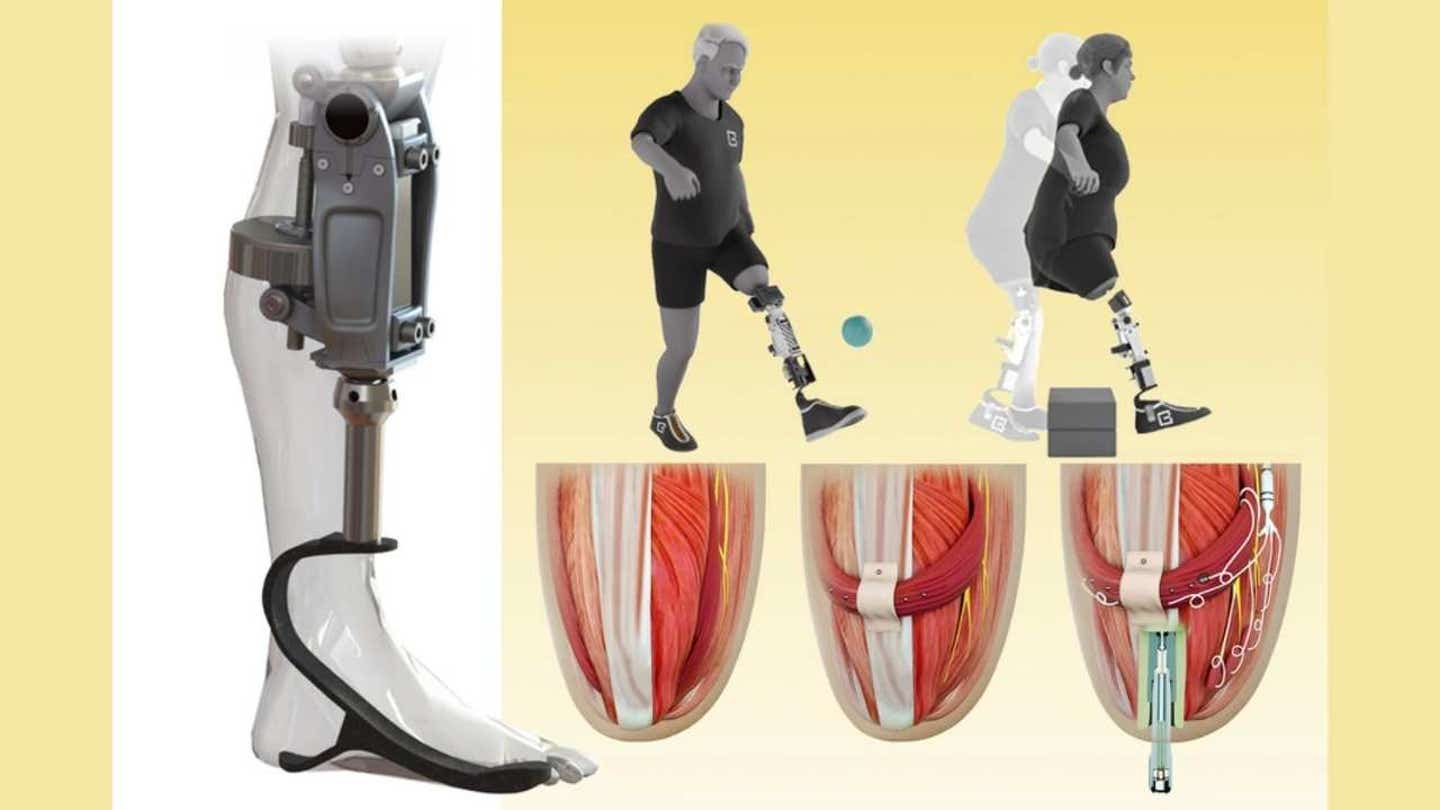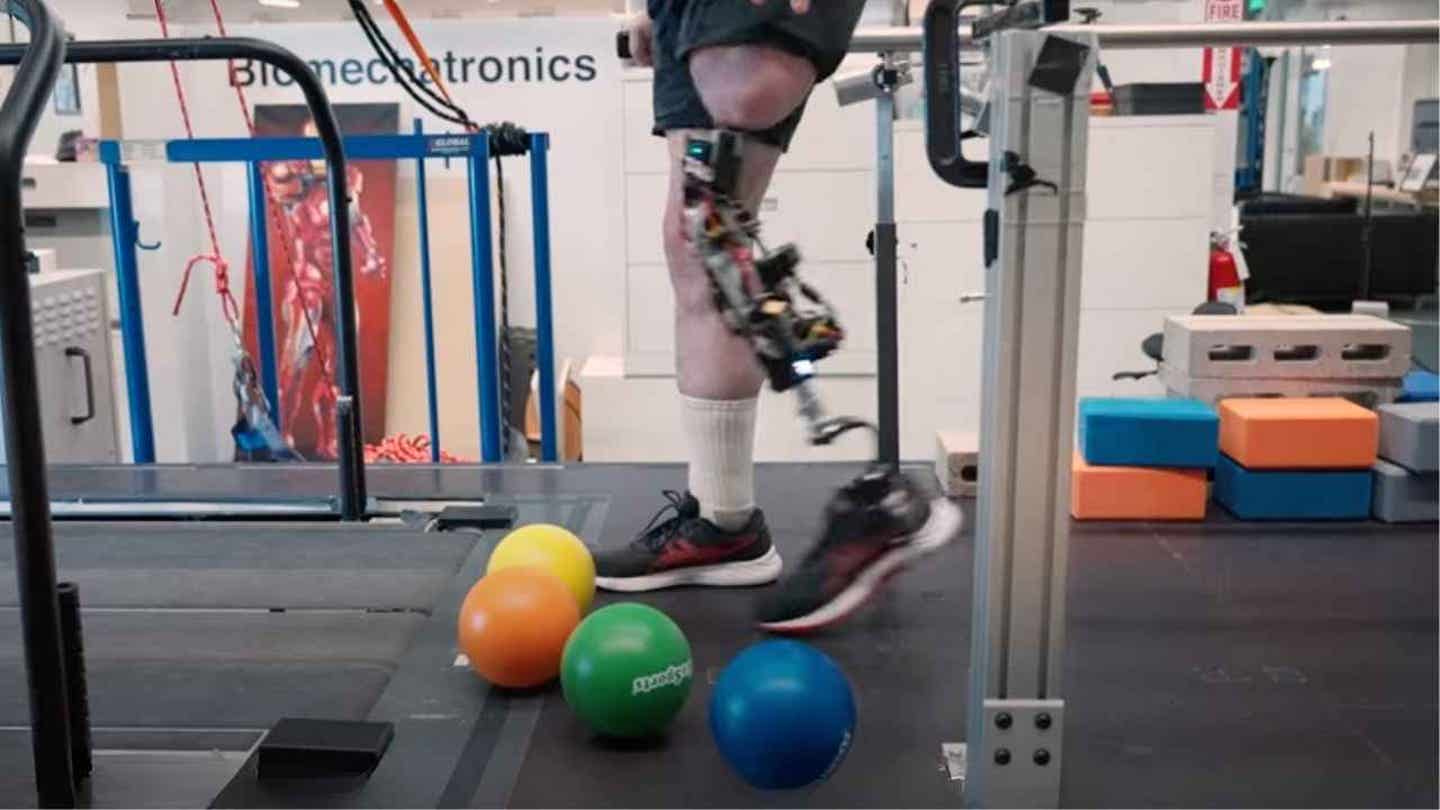Kicking a ball or climbing stairs with ease after a leg amputation above the knee is now a possibility. Researchers at MIT have developed a bionic knee that revolutionizes mobility for above-the-knee amputees. Unlike traditional socket-based prosthetics, this system attaches directly to the bone and integrates with the surrounding muscle tissue, resulting in faster, smoother, and more natural movement.
Under the leadership of Professor Hugh Herr, the MIT team has created a solution that goes beyond mimicking motion – it responds to intent. This high level of control enables the prosthesis to move in harmony with the body, providing a seamless experience that challenges the conventional idea of artificial limbs.
A man kicking a ball while wearing the e-OPRA bionic knee prosthesis. (MIT)
How the e-OPRA bionic knee for amputees works
The technology, known as e-OPRA (Enhanced Osseointegrated Prostheses for the Rehabilitation of Amputees), involves surgically implanting a titanium rod into the femur, which connects directly to a robotic prosthetic limb. This rod serves as the foundation of a new type of interface between the body and machine.
Through a specialized surgical technique called Agonist-Antagonist Myoneural Interface (AMI), muscles are reconnected in functional pairs. These muscles communicate with each other, sending signals to the robotic controller to determine the precise movement of the knee, mimicking the natural function of a real leg.

Illustration of a new e-OPRA bionic knee that can help people with above-the-knee amputations. (MIT)
Natural movement restored with the bionic knee for amputees
In trials, two patients using this integrated system not only performed better, but they also experienced improved mobility. They moved more quickly, climbed stairs with greater ease, and navigated obstacles with increased confidence. Most importantly, they felt like the prosthetic limb was a natural extension of their body.
One participant with only a few inches of thigh remaining could walk, pivot, and kick a ball smoothly. This intuitive, natural movement is a game-changer for above-the-knee amputees.

A man kicking balls while wearing the e-OPRA bionic knee prosthesis. (MIT)
Why the bionic knee for amputees is a major breakthrough
Traditional socket-based prosthetics can be uncomfortable, unstable, and prone to infections. They often feel foreign, like a tool strapped to the body rather than a part of it. The bionic knee eliminates the need for a socket by connecting directly to bone and muscle, improving load-bearing capacity, reducing skin issues, and most importantly, restoring a sense of control.
Control isn’t just physical, it also has emotional and psychological implications. Patients using the e-OPRA system reported a greater sense of agency and body ownership compared to those with traditional prosthetics.
MIT’s bionic knee for amputees driven by lived experience
Professor Hugh Herr, a double leg amputee himself, is not only leading the research but living it. After losing both legs below the knee in his teens, he returned to mountain climbing and dedicated his career to advancing prosthetic technology. His personal journey fuels the lab at MIT that continues to push the boundaries of biomechatronics, potentially changing the lives of above-the-knee amputees worldwide.
When the bionic knee for amputees will be available
Although the results are groundbreaking, the e-OPRA system is not yet available on the market. Further clinical trials and FDA approval are still required. Herr estimates that within five years, this technology could be more accessible to patients.
Kurt’s key takeaways
The bionic knee developed by MIT is reshaping the future of prosthetics. By combining advanced robotics with the human nervous system, it offers amputees a priceless sensation – the feeling of wholeness in their body once again.
What role should technology play in redefining the limits of the human body? Share your thoughts with us at CyberGuy.com/Contact.
Copyright 2025 CyberGuy.com. All rights reserved.
Kurt “CyberGuy” Knutsson is an award-winning tech journalist with a passion for technology, gear, and gadgets. Connect with Kurt and get tech tips at CyberGuy.com.





